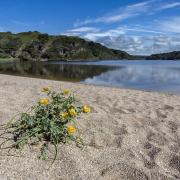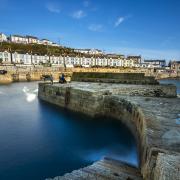In this April issue, Cornwall Life talks to the Prince's Regeneration Trust about its plans for The Old Duchy Palace it has recently rescued. The Palace was one of the most important buildings in Cornwall
Saviour of The Old Duchy Palace, The Prince's Regeneration Trust has exciting plans for its future, writes Rosie Fraser
The Old Duchy Palace in Lostwithiel holds a unique place in Cornwall's history. Thought to be the oldest and largest secular medieval building in the county, it played a central role in the tin industry for centuries and has had royal connections from the start. Still visible is a carving of the Prince of Wales' plume of feathers, which historians say was probably erected by the Black Prince (the first Duke of Cornwall) when he paid his first visit to Lostwithiel and Restormel Castle in 1353. So it is appropriate that 656 years later The Prince's Regeneration Trust, the charity founded by HRH The Prince of Wales to focus on heritage-led regeneration, has rescued the palace from falling into neglect. "We are now working to preserve the Grade I Listed building and establish an appropriate economical and sustainable new use that also enables some public access to this important local landmark. Benefiting the community is central to the way we run these projects," says Rosie Fraser, Commercial Director of The Prince's Regeneration Trust.
The original Duchy Palace was built around 1292 by Edmund, Earl of Cornwall, reputedly as a replica of the Great Hall of Westminster - and was probably known at first as the Great Hall of Lostwithiel. Edmund was the grandson of King John and nephew of Henry III. Though never a ducal residence, or a palace as it is understood today, it served as the administrative centre of the Duchy of Cornwall and was regarded as the finest and grandest building in the county. It was at one time the only polling station in Cornwall.
The Palace covered more than two acres and no other building in the county can claim so many vital functions, mainly to do with tin mining. Lostwithiel was the most important of Cornwall's four stannary towns: this made the Palace the most significant stannary building, in which the County Court and Stannary Court were held, and it was the seat of the Stannary Parliament until 1752. It was probably the first 'count house' (account or counting house) for the tin industry and contained the earliest known strongroom for business activity in Cornwall. It was also used as a coinage hall, the word 'coinage' deriving from the practice of removing the corner ('quoin') from an ingot of tin to test for purity and value.
During the Elizabethan period, following a period of neglect, the building was remodelled and the roof replaced, but was later damaged during the Civil War. More repairs followed in subsequent years, but once it was no longer used for county business, the old buildings served many different purposes - the old prison was let for dwellings and the vaults for stores and part for the Duchy offices. Over the centuries, sections of the original building have been demolished or incorporated into surrounding properties, but what is now the Old Duchy Palace was bought in 1878 by the Restormel Lodge of the Freemasons. This part of the building is thought to have started out as the kitchen of the Great Hall, but became the stannary for the assay of tin, an important political and revenue-generating function reserved for the Duchy of Cornwall.
In recent years the building has been underused and is now surplus to the Freemasons' requirements. Local people were alarmed by the prospect of it falling derelict, so the Cornwall Building Preservation Trust (CBPT) and Cornwall County Council stepped in and introduced the project to The Prince's Regeneration Trust. Recognising its importance, the Duke of Cornwall Benevolent Fund assisted with the finance needed to buy the building. The Prince's Regeneration Trust operates across the UK, mainly working in deprived areas, and its projects help redundant or 'at-risk' buildings to perform a new function. The CBPT charity is supported by six district and county councils, and exists to protect, acquire, conserve and reuse historic buildings across Cornwall.
"We are now working hard to secure the grant and donor funding needed to implement our plans to renovate the property in a manner that is sympathetic to its historic character and important medieval architecture, before it is put to a sustainable long-term use," says Rosie. "We are fortunate to be working with the CBPT as our local partner and will meet local councils, relevant partners, heritage experts, potential donors and representatives from the local community, to bring in as much support as possible, particularly to help raise the additional money needed for repairs and renovation."
"We are still investigating the best options for the Palace's long-term future, following an initial feasibility study commissioned by the CBPT that identified a range of options. The space is not huge and we have determined that it is not appropriate for holiday accommodation, for example," Rosie continues. "Ensuring some public access is important to continue the Palace's 700-year history at the heart of the Lostwithiel community. A mix of uses may be the most appropriate way forward.
"Our aim is that this project will bring substantial benefits to Lostwithiel, such as creating jobs, introducing new business to the area for the benefit of other local traders, and bringing public and private-sector funding to the area," she adds.
Loss of heritage means not just losing important links with the past that are highly valued by communities but also the erosion of those things that differentiate one town or city from another. Speaking last year, HRH The Prince of Wales said: "Heritage-led regeneration, not wasting precious assets, respecting dedication, skill and commitment of our forebears - we owe it to them, the unsung craftsmen and women, to honour their memory and to convert and to reuse the legacy they have left us."
For further information on the work ofThe Prince's Regeneration Trust visit www.princes-regeneration.org


























